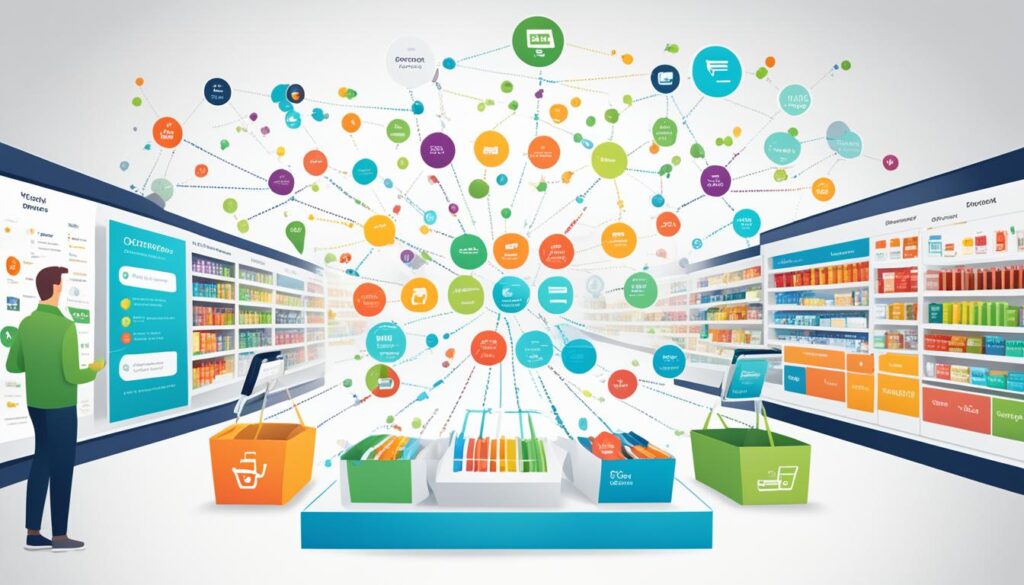Welcome to our article on the impact of big data in the retail industry and how it can enhance your shopping experience. In today’s digital age, data has become a powerful tool for retailers to understand their customers better and personalize their offerings. By leveraging big data analytics, retailers can optimize pricing, streamline operations, and improve customer engagement.
Key Takeaways:
- Big data is revolutionizing the retail industry, providing valuable insights into customer behavior and preferences.
- Personalized marketing strategies can be created by leveraging customer segmentation techniques.
- Predictive analytics enables retailers to forecast emerging trends and optimize marketing strategies.
- Enhanced customer service can be achieved by analyzing customer interactions and feedback.
- Big data helps retailers optimize the omnichannel experience, creating seamless shopping journeys for customers.
Big Data in Retail: An Overview
Big data plays a vital role in retail by allowing companies to gather and analyze vast amounts of customer data. With the help of retail data analytics, retailers can gain valuable data-driven insights into customer behavior, preferences, and purchasing patterns.
This information enables retailers to create personalized marketing strategies, optimize pricing, streamline operations, and make informed business decisions. By utilizing customer segmentation techniques, retailers can effectively target specific customer groups and provide tailored shopping experiences, driving customer satisfaction and loyalty.
Through data analysis, retailers can uncover trends, identify customer needs, and understand changing market dynamics. These insights inform retailers’ decisions, helping them enhance marketing campaigns, improve product offerings, and deliver exceptional customer experiences.
The Power of Retail Data Analytics
Retail data analytics empower retailers to unlock key insights from their data. By implementing data-driven strategies, companies can:
- Identify customer segments: With customer segmentation techniques, retailers can categorize customers based on various attributes such as demographics, purchasing habits, and preferences. This allows them to personalize their marketing efforts and tailor promotions to specific customer segments.
- Optimize pricing: By analyzing customer behavior and market trends, retailers can implement dynamic pricing strategies that maximize revenue and competitiveness. Data-driven price optimization ensures that retailers offer the right pricing to attract and retain customers.
- Streamline operations: Through data analysis, retailers can identify areas of improvement in their supply chain management and optimize inventory levels. Real-time data analysis enables proactive decision-making, reducing costs and enhancing operational efficiency.
Overall, retail data analytics and the insights derived from it play a critical role in helping retailers make data-driven decisions that lead to improved customer experiences, increased profitability, and sustained growth.
Benefits of Big Data in Retail
Using big data analytics in retail offers several benefits for both retailers and customers. By harnessing the power of predictive analytics, retailers can gain valuable insights into emerging trends, allowing them to forecast customer demands and optimize marketing strategies. This enables them to target the right customers at the right time, maximizing sales and profitability.
One of the key advantages of leveraging big data in retail is enhanced customer service. By analyzing customer interactions, feedback, and preferences, retailers can gain a deeper understanding of their customers and provide personalized assistance. This allows for a more tailored shopping experience, ensuring customer satisfaction and loyalty.
Moreover, big data facilitates omnichannel optimization in retail. By integrating online and offline channels, retailers can create seamless shopping journeys for their customers. This enables customers to interact with the brand through multiple touchpoints, such as mobile apps, websites, and physical stores, ensuring a consistent and convenient shopping experience.
“With big data, retailers can anticipate customer needs, personalize interactions, and optimize the omnichannel experience,” says Sarah Miller, data analytics expert at XYZ Retail Group. “This not only drives customer satisfaction but also fosters customer loyalty and long-term profitability.”
To illustrate the benefits of big data in retail, consider the following scenarios:
Scenario 1: Predictive Analytics in Shopping
Using big data analytics, a fashion retailer can analyze historical purchase data, social media trends, and industry insights to identify emerging fashion trends. By accurately predicting these trends, the retailer can proactively stock and promote the trending products, capturing customer interest and boosting sales.
Scenario 2: Enhanced Customer Service
A department store analyzes customer interactions and feedback across various touchpoints, such as in-store visits, online chats, and social media comments. By identifying common pain points and areas for improvement, the store can enhance its customer service by addressing customer concerns and providing personalized assistance, resulting in higher customer satisfaction and loyalty.
Scenario 3: Omnichannel Optimization
A retailer integrates its online and offline channels, providing customers with the option to purchase products through both mediums. Customers can seamlessly transition from online browsing to in-store try-ons or vice versa. Moreover, their purchase history and preferences are synchronized across all channels, ensuring a consistent and personalized shopping experience.
By utilizing big data analytics in retail, businesses can generate valuable insights, optimize operations, and deliver exceptional customer experiences. The data-driven approach empowers retailers to stay ahead of trends, provide personalized customer service, and create seamless omnichannel experiences, ultimately fostering long-term customer loyalty and profitability.
| Benefits of Big Data in Retail | Examples |
|---|---|
| Predictive Analytics in Shopping | Analyzing fashion trends to proactively stock and promote trending products |
| Enhanced Customer Service | Analyzing customer interactions and feedback to address pain points and provide personalized assistance |
| Omnichannel Optimization | Integrating online and offline channels for a seamless shopping experience across touchpoints |

Big Data in Retail: 360-Degree View of the Customer
One of the key aspects of using big data in retail is gaining a 360-degree view of the customer. By collecting and analyzing various data points such as demographic information, purchase history, social media presence, and preferences, retailers can create personalized marketing strategies. This allows them to target customers more effectively and find cost-effective alternatives to traditional celebrity brand ambassadors, such as micro-influencers. Big data enables retailers to tailor their messaging and offers to individual customers, enhancing customer engagement and loyalty.
Having a comprehensive understanding of the customer is essential for retailers to deliver personalized experiences and cater to their specific needs. By utilizing advanced data analytics tools, retailers can gather vast amounts of data from various sources. This customer data collection process involves analyzing both structured and unstructured data, providing valuable insights into customer behavior and preferences.
Personalized marketing strategies allow retailers to connect with customers on a deeper level, providing them with relevant and targeted communication. By leveraging customer data, retailers can segment their customer base and create tailored marketing campaigns that resonate with specific groups. This approach goes beyond demographic segmentation and dives into individual preferences and purchasing habits, resulting in more impactful marketing initiatives.
According to a study by McKinsey, 35% of Amazon’s sales come from personalized recommendations based on customers’ previous purchases and browsing behavior.
Micro-influencers, on the other hand, offer a cost-effective alternative to celebrity endorsements. These individuals have a smaller but highly engaged social media following and are often perceived as more relatable and trustworthy by their audience. By leveraging big data insights, retailers can identify micro-influencers who align with their brand values and target audience. Collaborating with micro-influencers can help retailers expand their reach and drive customer engagement in a more authentic and targeted way.
Research conducted by ExpertVoice shows that 82% of consumers are more likely to follow a recommendation made by a micro-influencer.
By harnessing the power of big data, retailers can gain a deeper understanding of their customers and develop personalized marketing strategies that resonate with their target audience. Whether it’s delivering targeted offers, recommending relevant products, or collaborating with micro-influencers, big data empowers retailers to create meaningful connections and drive customer loyalty.

Big Data in Retail: Price Optimization
One of the significant advantages of using big data in the retail industry is its potential to optimize pricing strategies. By leveraging customer purchasing habits, geographical location, and market trends, retailers can uncover valuable insights that enable them to stay competitive and maximize profits.
Dynamic pricing is a key component of price optimization, allowing retailers to adjust prices in real-time based on demand and supply dynamics. By monitoring relevant search words and leveraging the 360-degree view of the customer, retailers can anticipate upcoming trends and adjust prices accordingly. This approach helps retailers align their pricing with customer expectations and preferences, ultimately strengthening their competitive advantage.
Understanding customer purchasing habits is essential for effective price optimization. Big data analytics can provide valuable insights into which products customers are most likely to buy, at what price points, and through which channels. By analyzing these patterns, retailers can tailor their pricing strategies to meet customer expectations and optimize their sales performance.
Moreover, market trends play a crucial role in price optimization. By analyzing market dynamics and competitor pricing strategies, retailers can adjust their own prices to maintain a competitive edge. Big data enables retailers to stay updated with market shifts, identify potential pricing opportunities, and ensure that their offerings are attractively positioned to capture customer attention.
Leveraging Competitive Advantage
Price optimization through big data analysis offers retailers a competitive advantage in a crowded marketplace. By gaining a comprehensive understanding of customer purchasing habits and effectively adjusting pricing strategies, retailers can stand out from the competition by offering the right products at the right price.
With big data, retailers can determine the optimal price points that attract customers while maximizing profitability, creating a win-win situation for both the business and the consumer.
Furthermore, price optimization enables retailers to respond quickly to market changes and competitor actions. By continuously monitoring data, retailers can identify pricing gaps, adjust their strategies, and gain a competitive edge. With the right use of big data analytics, retailers can position themselves as leaders in the market, reflecting their ability to provide customers with value-driven pricing models.
Case Study: Retailer XYZ

| Date | Product | Original Price | Adjusted Price |
|---|---|---|---|
| 01/01/2022 | Smartphone XYZ | $599 | $519 |
| 01/02/2022 | Laptop ABC | $899 | $799 |
| 01/03/2022 | Headphones DEF | $199 | $169 |
Let’s take the example of retailer XYZ, which uses big data analytics for price optimization. By analyzing customer purchasing habits and market trends, XYZ identified that customers tend to be more price-sensitive during specific periods, such as holiday seasons when demand is high. XYZ adjusted its pricing strategy accordingly by offering discounts on popular products during those periods. For instance, on January 1st, the original price of the Smartphone XYZ was $599, but XYZ adjusted it to $519, resulting in increased sales and customer satisfaction.
By leveraging big data insights to optimize prices, retailers like XYZ can attract more customers, increase sales, and improve customer satisfaction while maintaining a competitive advantage in the retail industry.
Big Data in Retail: Streamlined Operations
Big data plays a crucial role in streamlining retail operations, particularly in supply chain management. By gathering and analyzing real-time data from various sources, retailers can optimize inventory management, track product performance, and ensure perfect stock levels throughout the year.
With real-time data analysis, retailers can make informed decisions and respond quickly to changes in customer demand and market trends. This allows them to adjust their inventory levels promptly, minimizing stockouts and reducing excess stock. By accurately predicting future demand, retailers can create a more efficient supply chain and improve customer satisfaction.
One of the major advantages of using big data in supply chain management is its ability to identify operational inefficiencies. By analyzing data from different touchpoints in the supply chain, retailers can pinpoint areas that require improvement, such as bottlenecks in distribution or delays in transportation. This enables them to optimize logistics, reduce costs, and deliver products to customers in a timely manner.
Real-time data analysis also helps retailers proactively address disruptions in the supply chain. By monitoring external factors like weather conditions or geopolitical events, retailers can identify potential risks and take appropriate measures to mitigate their impact. This ensures a smoother flow of goods from suppliers to warehouses and ultimately to stores or customers.
Benefits of Streamlined Operations Using Big Data in Retail:
- Optimized inventory management
- Improved responsiveness to customer demand
- Reduced stockouts and excess stock
- Enhanced supply chain efficiency
- Cost savings through operational optimization
By leveraging data-driven insights, retailers can streamline back-office operations and enhance overall efficiency. With real-time data analysis, supply chain management becomes more effective, ensuring perfect stock levels and seamless operations.

Big Data in Retail: Enhanced Customer Service
Big data has proven to be a game-changer for retailers when it comes to enhancing customer service. By leveraging data-driven insights, retailers can analyze customer interactions, sentiments, and feedback to improve the shopping experience.
One powerful tool in enhancing customer service is sentiment analysis. By using advanced algorithms, retailers can analyze customer sentiments expressed through reviews, comments, and social media interactions. This helps retailers understand customer preferences, satisfaction levels, and areas for improvement.
“The ability to understand customer sentiment allows retailers to make data-driven decisions that align with customer expectations, providing a better overall shopping experience.”
Additionally, analyzing customer reviews and comments provides valuable insights into product performance and quality. By understanding what customers like and dislike, retailers can make informed decisions about product offerings and address any issues or concerns.
Another way big data enhances customer service is through in-store optimization. By utilizing data from motion sensors and video footage, retailers can strategically place products, optimize store layouts, and improve the overall customer experience. This data-driven approach ensures that customers can easily navigate the store, find what they need, and have a seamless shopping experience.
Here is an example of how big data is used to optimize in-store experiences:
| In-Store Optimization | Description |
|---|---|
| Heatmap Analysis | Analyzing customer movement patterns through heatmaps to identify high-traffic areas and optimize product placement. |
| Queue Management | Using real-time data analysis to optimize checkout queues, reducing waiting times for customers. |
| Personalized Recommendations | Using customer data to offer personalized recommendations in-store, increasing upsell and cross-sell opportunities. |
With sentiment analysis, customer review analysis, and in-store optimization, big data enables retailers to consistently enhance their customer service and satisfaction levels.
Next, we will explore how big data plays a crucial role in optimizing pricing strategies in the retail industry.
Conclusion
Big data has revolutionized the retail industry, providing retailers with the power to deliver personalized shopping experiences and drive customer engagement. By leveraging data-driven insights, retailers can optimize pricing, streamline operations, and enhance customer service, ultimately gaining a competitive edge in the retail industry.
The use of big data in retail offers several benefits, including predictive analytics that allow retailers to forecast emerging trends and optimize marketing strategies. Enhanced customer service can be achieved by analyzing customer interactions and feedback, enabling retailers to provide personalized assistance and resolve issues more effectively. Additionally, big data helps retailers optimize the omnichannel experience by integrating online and offline channels, creating seamless shopping journeys for customers.
As the retail industry continues to evolve, big data will play a crucial role in helping retailers stay competitive and deliver unmatched personalization to their customers. By harnessing the power of big data, retailers can gain valuable insights into customer behavior, preferences, and purchasing patterns, leading to more targeted marketing efforts and improved customer satisfaction. With big data, retailers have the tools they need to thrive in the ever-changing retail landscape and provide personalized shopping experiences that keep customers coming back for more.
FAQ
How does big data enhance the shopping journey in retail?
Big data allows retailers to gather and analyze customer data, enabling them to create personalized marketing strategies, optimize pricing, and streamline operations to enhance the overall shopping experience.
What insights can retailers gain from data analytics in retail?
Data analytics provides valuable insights into customer behavior, preferences, and purchasing patterns, empowering retailers to make informed business decisions and optimize their marketing strategies.
What are the benefits of using big data in retail?
By leveraging big data, retailers can utilize predictive analytics to forecast trends, enhance customer service through improved personalization, and optimize the omnichannel experience by integrating online and offline channels.
How can retailers personalize the shopping experience using big data?
By collecting and analyzing various customer data points, such as demographics, purchase history, and social media presence, retailers can create personalized marketing strategies and tailor their messaging and offers to individual customers, enhancing customer engagement and loyalty.
How does big data help retailers optimize pricing strategies?
Big data allows retailers to analyze customer purchasing habits, geographical location, and market trends, enabling them to anticipate upcoming trends and adjust prices accordingly, helping them stay competitive and maximize profits.
What role does big data play in streamlining retail operations?
Big data helps retailers optimize inventory management, track product performance, and ensure perfect stock levels throughout the year by gathering and analyzing real-time data. It also helps identify operational inefficiencies, improve logistics, and reduce costs.
How does big data enhance customer service in retail?
By analyzing customer interactions, feedback, and sentiments, retailers can identify preferences and satisfaction levels, make improvements, and provide a better shopping experience. It also helps to strategically place products in-store and consistently enhance customer service and satisfaction levels.








